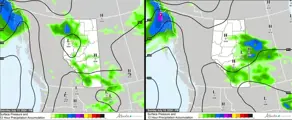Moisture Update - July 10, 2024

Maps 1, 2, 3, 4, & 5: Since the last report, a heatwave has settled in over the province, bringing with it a strong drying trend. Over the past four days, the highest temperature measured was 37.8 degrees Celsius at the Parlbly Creek station, located north east of Red Deer (Map 1). Several locales in each of the four agricultural regions, topped 35 degrees Celsius and few managed to escape temperatures above the 33 degrees Celsius mark. For perspective, the highest temperature ever recorded in Alberta, occurred on July 21, 1931, at a scorching 43.3 degrees Celsius. Manitoba's heat record was set in 1936 at 44.4 degrees Celsius, while Saskatchewan holds the prairie record of 45 degrees Celsius in 1937. The 1930’s followed a stretch with many dry years, starting in approximately 1910. It wasn’t until the late 1940’s, that generally cooler, wetter weather prevailed, lasting well into the 1990’s.
With the recent hot weather came very dry air, and many areas have not seen any precipitation over the past 6-days (Map 2). Some relief was seen in a few areas across the central parts of the province, along with the north central Peace Region and the south eastern portions of the Southern Region. However, most of these areas received less than 10 mm of precipitation
Looking forward, a weak low pressure system is set to move into the province later on July 11, bringing in some moisture over the next several days (Maps 3, 4, and 5). This is expected to finish early next week, when we will see a return to warmer temperatures and clear skies, albeit likely not as hot as what we have experienced this week.
Looking forward 10-days, forecast models start to disagree, with some indicating a cooling trend and some predicting that the heat will build. At this point, it’s anyone’s guess.
60-Day Precipitation Trends
Maps 6, 7, & 8: Due to a lack of rain over the past week, 60-day precipitation deficits are intensifying and expanding, and now extend across most of the North West and North East Regions, north-western portions of the Central Region, and parts of the Southern Region (Map 6). The driest areas are found in Camrose and Flagstaff Counties, with once in 25-year lows beginning to emerge. Several lands have seen less than 70% of normal rainfall, with some small pockets of less than 50% of average appearing in each of the four regions (Map 7). Total precipitation accumulations range from less than 60 mm in some areas, to over 260 mm through parts of the eastern Peace Region (Map 8).
Soil Moisture Reserves Relative to Normal
Maps 9, 10, & 11: Current soil moisture reserves generally mimic the story portrayed in the 60-day precipitation maps. Much of the North West, North East, and portions of the Peace and Central Regions, have well below normal reserves for this time of year, with small pockets of less than once in 25-year lows present near Grande Prairie, High Level, and Forestburg (Map 9). In contrast, soil moisture reserves are above normal in parts of the Special Areas, the Southern Region, and the eastern portions of the Peace Region. However, soil moisture reserves are normally quite low at this time of year across most of the Special Areas and throughout the Southern Region (Map 10).
Looking at current estimated soil moisture reserves, several areas have less than 40 mm available to plants and some lands are very dry in each of the four regions, with less than 20 mm of available water remaining to plants (Map 11). Currently, these areas are highly prone to moisture stress in the face of the heat, as at this time of year, crops need about 25 mm a week of moisture to thrive. This is supplied either through rainfall or reserves of soil moisture. Thankfully, we are expecting a cool down over the next few days, and hopefully some rain will bring immediate relief.
Perspective
It’s uncertain what effect recent moisture deficits will have on this year’s crop yields, but it is clear that optimal growth will not be maintained in many of the dry areas. Next week’s Alberta Crop Report should shed some light on how this heat has been affecting crops. Moving forward, rain and cooler temperatures will be needed very soon if current yield potential is to remain on track.
Contact Us
Saddle Hills
Junction of Hwy 49 & Secondary Hwy 725
RR1, Spirit River AB
T0H 3G0
T. 780-864-3760
Fax 780-864-3904
Toll-free 1-888-864-3760
frontdesk@saddlehills.ab.ca
Sign up to our Newsletter
Stay up to date on the Saddle Hills activities, events, programs and operations by subscribing to our eNewsletters.










